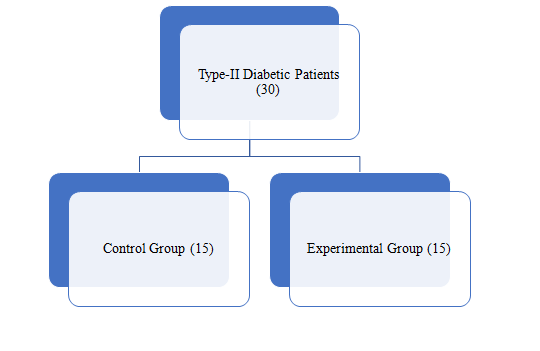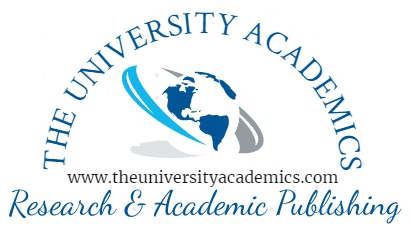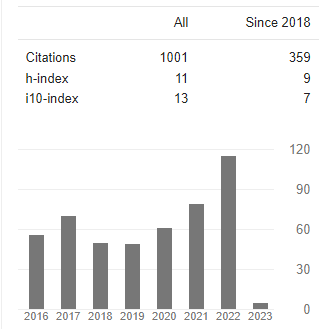EFFECT OF SIX WEEKS THERAPEUTIC EXERCISES TRAINING ON CHOLESTEROL LEVEL & DIASTOLIC BLOOD PRESSURE AMONG TYPE II DIABETIC PATIENTS
Abstract
The aim of this study: The focus of this investigation was to find out the effect of six weeks therapeutic training on cholesterol level & diastolic blood pressure among type-II diabetes patients.
Methodology: Thirty male diabetic patients (15 control group + 15 experimental group) were selected for this study from two districts (Fazlika and Patiala) of Punjab state. The age of the subjects were ranged between 45 to 55 years. For the purpose of this study selected physiological variables were selected, there were cholesterol and diastolic blood pressure. Serum cholesterol was measured by “Erba Chem-5 V2 Plus” and Diastolic blood pressure was measured by “Sphygmomanometer, Stethoscope, and digital equipment. Paired t-test was employed to investigate the effect of six weeks therapeutic training on cholesterol level and diastolic blood pressure.
Results: Findings showed that there was significant effect of six weeks therapeutic training on selected physiological variable serum cholesterol (p =.043) and diastolic blood pressure (p =.012) among type-II diabetics patients.
Conclusion: The study concludes that therapeutic exercises training plan significantly contribute to improve the level of selected physiological variables (serum cholesterol and diastolic blood pressure) among type-II diabetes patients.
Downloads
References
Alliant Physical Therapy group. (2015). Therapeutic exercises, https://alliantpt.com/specialty-techniques/therapeutic -exercise.
CHAND PURI, P., MISHRA, P., JHAJHARIA, B., & SINGH, M. (2014). COORDINATIVE ABILITIES OF VOLLEYBALL IN DIFFERENT AGE GROUPS: A COMPARATIVE STUDY. International Journal of Behavioral Social and Movement Sciences, 3(3), 56–68. Retrieved from https://ijobsms.org/index.php/ijobsms/article/view/228
Dr.Mandeep Singh & J N Baliya, 2013; “A study of family stress among working and non-working parents”, International Journal of Research in Social Sciences.Vol 2, 2. 194-201. https://indianjournals.com/ijor.aspx?target=ijor:ijrss&volume=2&issue=2&article=013
David, L., and nelson M.C. (2013). Lehminger principles of biochemistry sixth edition publisher Susan Winslow PP. 859-864.
De Sousa, E. C., Abrahin, O., Ferreira, A. L. L., Rodrigues, R. P., Alves, E. A. C., & Vieira, R. P. (2017). Resistance training alone reduces systolic and diastolic blood pressure in prehypertensive and hypertensive individuals: meta-analysis. Hypertension Research, 40(11), 927-931.
Feher, J. J. (2017). Quantitative human physiology: an introduction. Academic press.
Godara, H.L. and Bishnoi, C. (2013). “Effect of aerobic training on percentage of body fat, total cholesterol and HDL-C among obese children.’’ IOSR Journal of Sports and Physical Education, 1(2):46-52.
Galicia-Garcia, U., Benito-Vicente, A., Jebari, S., Larrea-Sebal, A., Siddiqi, H., Uribe, K. B., ... & Martín, C. (2020). Pathophysiology of type 2 diabetes mellitus. International journal of molecular sciences, 21(17), 6275.
Kumar A., Verma L., & Monika (2003). “Exercise Prescription for Diabetics” pp 3-6.
Kisner, C., Colby, L. A., & Borstad, J. (2017). Therapeutic exercise: foundations and techniques. Fa Davis.
Powers, S. K., Howley, E. T., & Quindry, J. (2007). Exercise physiology: Theory and application to fitness and performance (p. 640). New York, NY: McGraw-Hill.
Singh Bakhsis (2022). Six weeks therapeutic exercises training on blood glucose and blood pressure among diabetes patients. Journal of shodhasamhita ISSN 2277-7067, vol. no. IX, Issue-11 (V) page no-68.
Singh, A., & Singh , D. M. (2013). PROMOTION OF RESEARCH CULTURE –ENHANCING QUALITY IN HIGHER EDUCATION. International Journal of Behavioral Social and Movement Sciences, 2(2), 202–208. Retrieved from https://ijobsms.org/index.php/ijobsms/article/view/152
SINGH, M., & SINGH SIDHU, A. (2016). A COMPARATIVE STUDY OF BODY COMPOSITION AND RELATIVE HEALTH STATUS AMONG RESIDENT AND NON-RESIDENT STUDENTS IN DIFFERENT SCHOOLS OF J&K. International Journal of Behavioral Social and Movement Sciences, 5(3), 08–13. Retrieved from https://ijobsms.org/index.php/ijobsms/article/view/320
Singh Nathial, D. M. (2012). ANALYZING THE CREDIT BASED SYSTEM IN PHYSICAL EDUCATION. International Journal of Behavioral Social and Movement Sciences, 1(3), 172–176. Retrieved from https://ijobsms.org/index.php/ijobsms/article/view/37
SHARMA, N. P., & SINGH, M. (2014). SENIOR AGE GROUP RELATIVE EXERCISES AND IMPACT ON THEIR LIFESTYLE. International Journal of Behavioral Social and Movement Sciences, 3(04), 78–82. Retrieved from https://ijobsms.org/index.php/ijobsms/article/view/246
Wuest, D. A., & Bucher, C. A. (1991). Foundations of physical education and sport. Mosby Incorporated.
Waugh A., Grant A., (2001). Anatomy and physiology in Health and wellness (9th Ed.) Churchill livingstone. Edunburgh London: New York Oxford Philadelphia St Lous Sydney and Toronto

Copyright (c) 2024 Manoj Singh, Bakhsis Singh

This work is licensed under a Creative Commons Attribution 4.0 International License.














